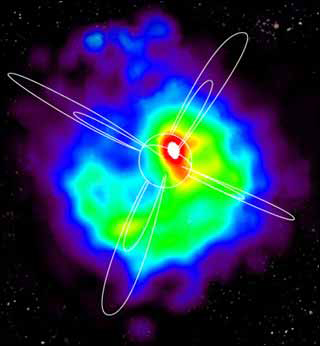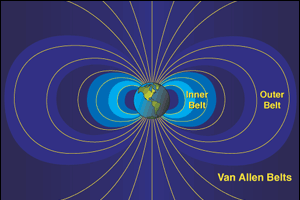
Ring
current shown around the Earth demonstrated
by images from IMAGE/HENA instruments.
The lines show the magnetic field as
viewed
from nearly above the North Pole. |
|
|
|
| |
The environment of Earth in space is a complicated stew of energetic particles such as protons and electrons. Space scientists have discovered, however, that it is possible to discern three distinct ingredients to this stew. Like salt and pepper mixed together, each system of particles has its own unique properties. The densities of these components are so low that the particles only occasionally collide with one another as they travel around Earth at speeds of thousands of kilometers per hour or more. One of these components, the Van Allen belts, is a well-known landmark of near-Earth space discovered at the dawn of the Space Age.
Van Allen Belts
Encircling the equatorial region of the Earth, and extending to latitudes nearly
as far as the Arctic Circle, the Van Allen belts form two, nested donuts of particles.
The inner belt contains 10 million-volt, high-energy protons (the stripped nuclei
of hydrogen atoms), and is located between 700 kilometers and 12,000 kilometers
from the Earth's surface. The outer belt contains mostly electrons with energies
higher than one million volts, located between 25,000 and 40,000 kilometers from
the Earth's surface. Both belts are severe radiation hazards for astronauts,
which is why the orbits of the International Space Station and typical Space
Shuttle
missions are well below the inner edges of these belts. The Van Allen belts are
always present in space, like fixed coral reefs in the ocean, which must be avoided
at all times.

| The
location of the inner and outer Van Allen radiation belts. |
|
|
| |
The Plasmasphere
A second population of particles, the plasmasphere, consists of low-energy particles with energies of a few tens of volts. Unlike the Space Shuttle which orbits Earth once every 90 minutes under the influence of gravity, plasmasphere particles are not under the influence of gravity at all. Earth's magnetic field is so strong that the plasmasphere particles are actually pulled along with Earth's 24-hour rotation at a much slower speed than the Space Shuttle. Like the Van Allen belts, the plasmasphere is a permanent feature of Earth's environment, though it is not a health hazard for astronauts.
The Ring Current
The third component of near-Earth space is the ring current which overlaps both the Van Allen belts and the plasmasphere from 8,000 to 30,000 kilometers from Earth. Ring current particles carry energies of several thousand volts, but unlike Saturn's rings, they do not flow in a complete ring around Earth. It is more prominent on the night time side of Earth, and it is at its strongest, carrying the most particles, during severe solar storm events which shake Earth's magnetosphere. This current of particles carries enough energy to actually change the strength of Earth's magnetic field even at ground level, especially in the equatorial regions. Although Van Allen belt particles are probably captured from the solar wind, and plasmasphere particles probably come from the upper atmosphere and ionosphere, the origin of the ring current particles is something of a scientific mystery. Scientists don't fully understand where they come from, or how they get energized to such high voltages within the magnetosphere.
Text adapted from the Sun-Earth Connection Tutorial courtesy
of NASA, originally written by
Dr. Sten Odenwald. Images and
videos courtesy of NASA unless otherwised noted.
Page 8 of 10 |
|
 |
|
 |
 |
Visit other pages in this section that focus on aspects of the Sun-Earth Connection.
|
|
 |
|
|




